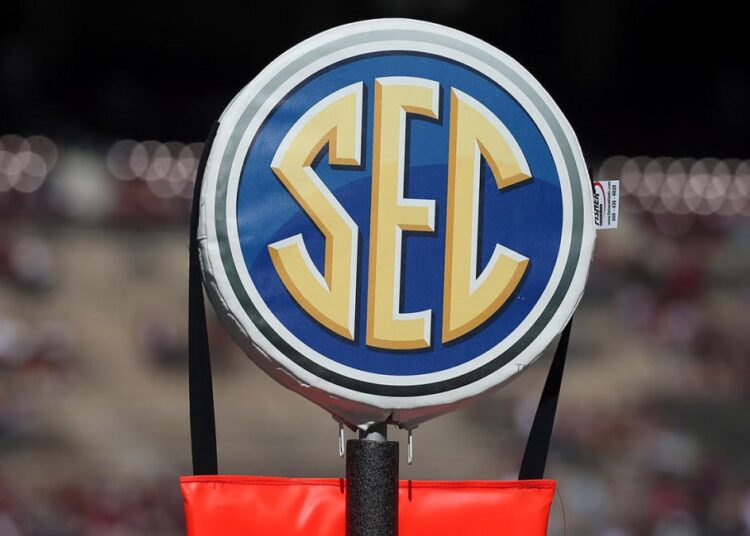Now that we know Texas and Oklahoma will leave the Big 12 and join the SEC in 2024, not 2025 as it was originally announced, the issue of determining the league’s football schedule has become a bit more pressing. The SEC has been mulling different models ever since the move — which kicked off this most recent wave of conference realignment — was first announced in July of 2021. Commissioner Greg Sankey and the league office have been waiting to finalize the schedule, however, until after the conclusion of the Big 12’s negotiations with Texas and Oklahoma.
How the league will approach its football schedule is expected to be one of the most pivotal issues at the conference’s upcoming spring meetings. Just don’t expect college football fans to wait until then to start imagining an SEC schedule with a whopping 16 teams, now featuring two of the sport’s iconic programs.
During Monday’s episode of the Cover 3 Podcast, we put ourselves in the board room of the SEC league office to determine the perfect conference schedule with Texas and Oklahoma in the fold. Before we could start pairing permanent partners, we had to start with some ground rules — or, at least, agree upon the general scheduling format:
- No divisions
- 9-game conference schedule
- 3-6 scheduling model with three annual rivals
It’s important to note the distinction between having three annual rivals and a pod; it’s widely believed the SEC is not interested in a true pod format in which every team in the pod plays each other, similar to a division. This scheduling model is attractive because it sets up a school to play every other SEC program over a two-year cycle, with both home and away games against every other school over a four-year cycle. Year 1 will have a team’s three annual rivals plus six other SEC opponents. Those six are then rotated out for the rest of the conference in Year 2, allowing for games against all 15 conference foes.
Long droughts between cross-division opponents who aren’t annual rivals are a common complaint of the division format. Alabama and Georgia, for example, have played just two regular-season, on-campus games in the last 15 years. This model eliminates that issue, but comes with the cost of an additional conference game. The SEC has held on to its eight-game schedule as the Big Ten, Pac-12 and Big 12 have all moved to nine conference games, but creating more connection between schools in this massive league — not to mention the additional inventory for the league’s TV partners — could spark the decision to expand the conference schedule.
Now, we come to the issue of establishing the three annual rivals for each school, a logic puzzle that will cause headaches and broken hearts. Some of the pieces on the board are easy: Florida will play Georgia every year, as will Alabama and Auburn, Alabama and Tennessee, and the league’s newcomers Texas and Oklahoma. Pairing schools gets difficult because you must consider not only historic rivalries but competitive balance, travel and (once again) the interests of those TV partners. Some SEC conference games that are played annually now won’t be once the league expands to 16 teams. At least in this format, every matchup is played every two years.
Check out the results of the exercise in the table below, plus takeaways with what we learned from taking on the challenge the SEC faces in the coming months.
Proposed SEC Annual Rivals
Return of Texas vs. Texas A&M
Like Georgia and Alabama, Texas quickly established a majority of its permanent rivals. The Longhorns will get Oklahoma as the SEC lands another iconic neutral-site rivalry to add to Florida-Georgia, and Texas A&M is added back to the schedule as a permanent rivalry. The in-state rivals played every season for nearly a century from 1915 to 2011, then stopped when Texas A&M made its move to the SEC. There have been state legislators who have attempted to force the resumption of the rivalry through law, campus-wide referendums of both student bodies and even public support from multiple sitting athletic directors, but ultimately no game was added to the books.
When we first started the debate, I was the lone dissenter who figured that Texas vs. Texas A&M was not guaranteed to be permanent rivalry — believing Oklahoma takes priority No. 1 and there might other moving pieces — but by the conclusion of the exercise my position had changed. The resumption of Texas and Texas A&M is a top-five headline from the SEC’s expansion, and the league would be wise to put that game in the spotlight every single season.
Tennessee has so many rivals
Tennessee was one of the schools that routinely popped up in conversation as we paired partners. The Vols are quite clearly going to get Alabama as one of their rivals and likely remain cemented for the third Saturday in October for eternity. However, there are multiple teams in the SEC East that Tennessee fans would call a rival … and only two more spots. Plus, there’s no guarantee that Tennessee is a top-two rivalry for those school and some competitive balance must be taken into consideration.
The Georgia-Tennessee rivalry was the first to go since the Bulldogs are already paired with Auburn and Florida. The Florida-Tennessee rivalry nearly made it, but was ultimately cut to make the pieces fit with Vanderbilt and Kentucky, which joined the Crimson Tide as Tennessee’s permanent partners.
Echoes of division play remain
There’s probably some bias involved in how we paired current SEC teams that are annual rivals in the division format, but the same considerations that helped establish those divisions are also going to power this new format. Proximity, for the teams but especially for the families and fans, is an attractive reason to have schools play each single season. Plus, playing in the same division for the last 30 years has helped build modern SEC rivalries that are going to be taken into consideration when pairing permanent partners.
Division play makes no sense for a 16-team league, however. Seven division games and just one or two cross-division games would again create the scheduling conundrum of teams playing only twice in 15 years. Still, it has played a key role in shaping the identities of the modern SEC. Of the 14 teams that make up the current SEC, five are slated to play current division rivals every year as annual partners: Florida, Kentucky, LSU, Mississippi State and South Carolina.
3-6 model remains best format
We had a few disagreements along the way that had to be settled by a vote, but at the conclusion it’s pretty clear that this format — with three permanent partners and six rotating opponents — is the best way to schedule a 16-team SEC. There are going to be some rivalries that get relegated to every-other-year status, but at least this way you still are guaranteed to see those teams every other year.
Getting rid of divisions also guarantees the SEC will get its two best teams in the SEC Championship Game every year. Having more competitive balance in the schedule should help the league’s strength of schedule ratings and better position more teams to make the expanded College Football Playoff. There’s no guarantee the SEC will choose a 3-6 scheduling model like we did, and even less of a chance it makes the exact same selections we did for permanent partners, but consider it the official recommendation of the Cover 3 Podcast.
Read the full article here























